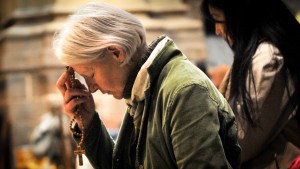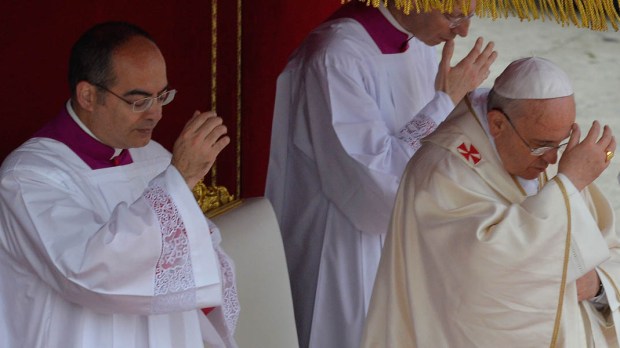For Roman Catholics, there is a quick gesture that can often go unnoticed before the recitation of the Gospel reading at Mass. It is a brief tracing of the cross that is not the typical gesture usually performed and contains much symbolism.

Read more:
When should you make the sign of the cross?
The gesture is a direct imitation of what the deacon (or priest when a deacon is not present) is instructed to do before he recites the words of the holy Gospel. The Roman Missal states, “Then, with the thumb of his right hand, he makes the sign of the cross first on the book at the beginning of the Gospel to be read, and then on himself on the forehead, mouth, and breast.”
Prior to that, if a deacon is going to proclaim the Gospel, the priest will give him a blessing where he recites the following prayer.
May the Lord be in your heart and on your lips, that you may proclaim his Gospel worthily and well, in the name of the Father and of the Son and of the Holy Spirit.
In a similar way, when the priest is the one to proclaim the Gospel, he prays these words silently.
Cleanse my heart and my lips, almighty God, that I may worthily proclaim your holy Gospel.
The laity and all others attending Mass, are invited to make a similar prayer and gesture before the Gospel is read. They are encouraged to say interiorly a brief prayer that prepares them to receive the Word of God.
May the Word of the Lord be on my mind, on my lips, and in my heart.
It is a beautiful action, one with deep biblical roots. For example, God explains to the people of Israel to recite a particular phrase (“Hear, O Israel …“) on a daily basis, but also to put that phrase “as a pendant on your forehead” (Deuteronomy 6:8). Many Jews took that literally and placed a small scroll on their forehead. It was a visible reminder to keep the Word of God always on their mind.
Secondly, the prayer is reminiscent of how the prophet Isaiah received a vision where an angel purified his lips with a burning coal (see Isaiah 6). This connection is presereved in the Extraordinary Form of the Mass, where the priest recites the following prayer before the Gospel.
Cleanse my heart and my lips, O Almighty God, Who cleansed the lips of the Prophet Isaiah with a burning coal. In Your gracious mercy deign so to purify me that I may worthily proclaim Your holy Gospel.
Last of all, the prayer recalls the words of the Letter to the Hebrews, where the author writes, “the word of God is living and effective, sharper than any two-edged sword, penetrating even between soul and spirit, joints and marrow, and able to discern reflections and thoughts of the heart” (Hebrews 4:12).
Thus, when we make such a gesture at Mass, it is truly a profound prayer, opening ourselves up to the words of Jesus Christ. Every time we listen to the Gospel Jesus is knocking at the door of our heart, waiting to get in. We just have to open the door.

Read more:
Why do Eastern Christians make the Sign of the Cross “backwards”?

Read more:
Why do Catholics make the Sign of the Cross before praying?

